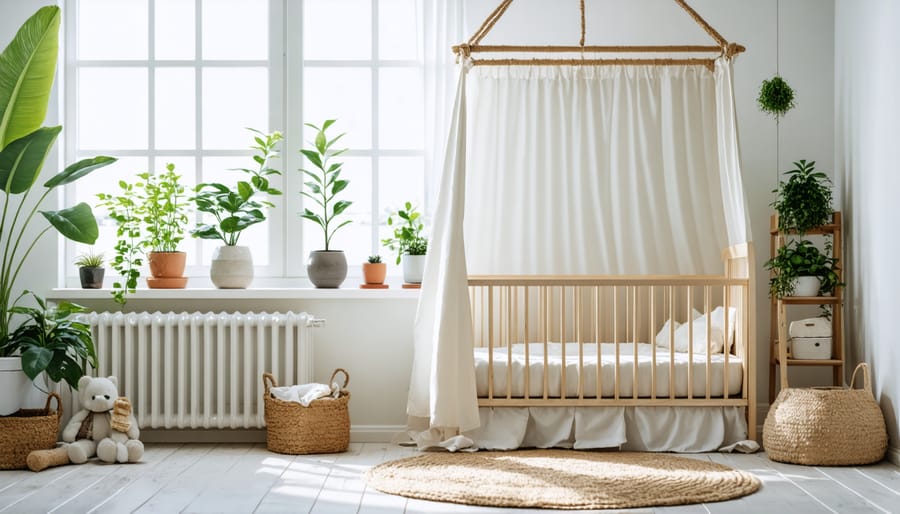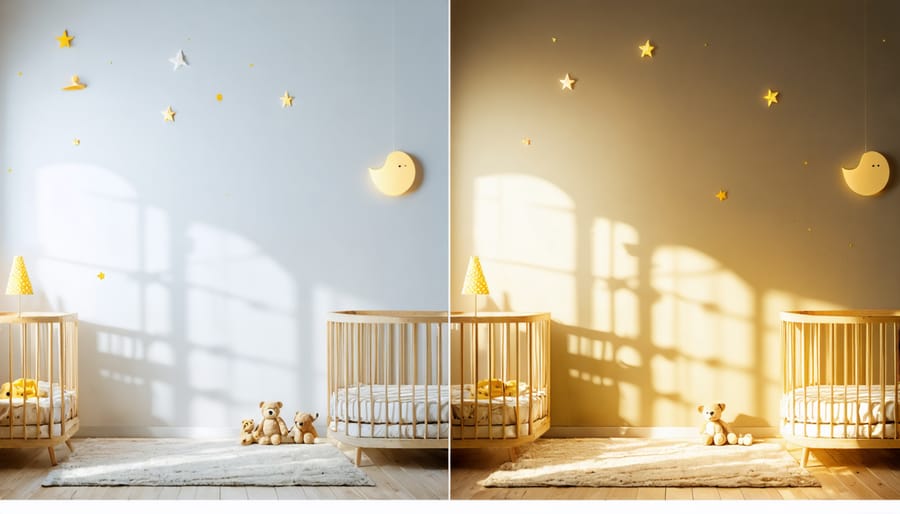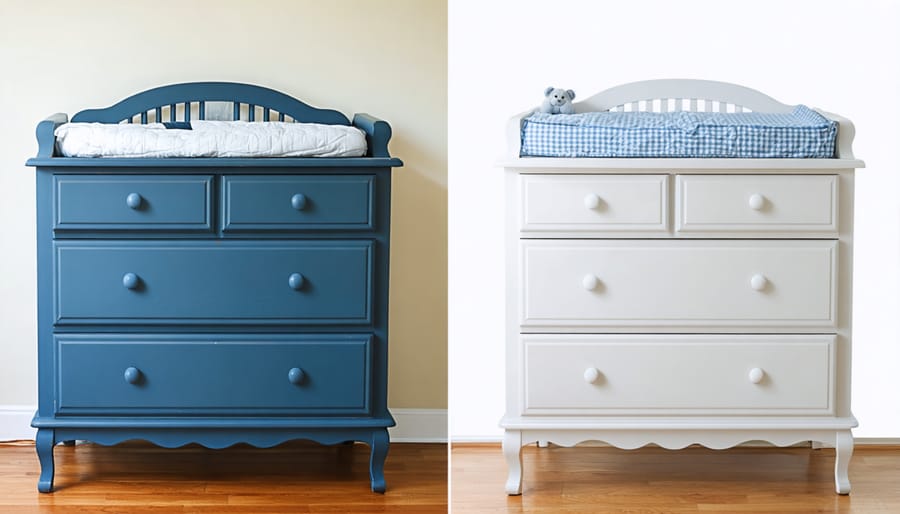Transform your baby’s nursery into an eco-friendly haven by selecting non-toxic, sustainably-sourced wooden furniture finished with zero-VOC paints. Create a naturally calming atmosphere with sage green walls, botanical prints, and organic cotton textiles that promote better sleep while minimizing environmental impact. Incorporate living plants like snake plants or spider plants to naturally purify the air, positioned safely out of reach while adding vibrant greenery to the space. Maximize natural light with sheer, GOTS-certified organic curtains, and install energy-efficient LED lighting with dimmer switches for nighttime feedings. Choose multi-functional, sustainable pieces – from bamboo storage bins to reclaimed wood floating shelves – that grow with your child while reducing waste. Every thoughtful choice in a green nursery contributes to both your baby’s health and our planet’s future, making it a worthwhile investment in sustainability and style.
Why Choose a Green Nursery?
Health Benefits for Your Baby
Creating a green nursery goes beyond environmental benefits – it’s a wonderful way to protect your baby’s health from day one. Babies are particularly sensitive to indoor air quality, and eco-friendly materials help create a safer sleeping environment by reducing harmful chemicals and toxins commonly found in traditional nursery items.
Natural materials like solid wood furniture, organic cotton bedding, and zero-VOC paints significantly decrease your little one’s exposure to off-gassing chemicals that can irritate their developing respiratory system. These safer alternatives eliminate the harsh chemicals found in conventional furniture finishes, synthetic fabrics, and standard paints.
Plants are another powerful ally in your green nursery. Besides adding a touch of nature, certain varieties act as natural air purifiers, filtering out common indoor pollutants. Just be sure to choose non-toxic species that are safe around babies.
By choosing eco-friendly materials, you’re creating a healthier space where your baby can grow, play, and thrive while developing a robust immune system in those crucial early years.
Environmental Impact
Creating an eco-friendly nursery isn’t just about style – it’s about making choices that benefit both your baby and our planet. Sustainable practices in nursery design can significantly reduce your carbon footprint while creating a healthier environment for your little one.
By choosing organic materials and VOC-free paints, you’re preventing harmful chemicals from entering both your home and the environment. Energy-efficient LED lighting cuts electricity consumption and lasts longer than traditional bulbs, reducing waste and saving money. Selecting furniture made from sustainably harvested wood or reclaimed materials helps preserve forests and minimizes manufacturing impacts.
Upcycling and repurposing items not only reduces landfill waste but also creates unique, personalized pieces for your nursery. Natural cleaning products protect local water systems and improve indoor air quality. Even small choices, like using washable cloth diapers or selecting toys made from renewable materials, can make a lasting positive impact on the environment while creating a safe, nurturing space for your baby.

Sustainable Material Choices
Natural and Non-Toxic Furniture
When creating a healthy nursery environment, selecting non-toxic furniture choices is crucial for your baby’s well-being. Start with a solid wood crib certified by GREENGUARD or made from sustainably harvested timber. Look for options finished with water-based, zero-VOC stains and sealants to ensure the safest sleep environment for your little one.
For storage and organization, consider bamboo dressers or reclaimed wood cabinets. These materials are not only eco-friendly but also incredibly durable, perfect for holding tiny clothes and nursery essentials. Many sustainable furniture brands now offer modular designs that grow with your child, making them both environmentally and economically smart choices.
When shopping for changing tables and rocking chairs, opt for pieces made from FSC-certified wood or natural materials like rattan and cork. These materials are renewable and biodegradable while adding beautiful texture to your nursery’s design. To maximize sustainability, explore secondhand marketplaces for gently used solid wood furniture that you can refinish with non-toxic paints.
Remember to check for third-party certifications and ask manufacturers about their production processes. The best sustainable furniture pieces combine clean materials, ethical manufacturing, and timeless design that can be passed down through generations or repurposed for other rooms as your child grows.
Organic Textiles and Bedding
When it comes to creating a truly eco-friendly nursery, choosing organic textiles and bedding is essential for both your baby’s health and the environment. Organic cotton leads the pack as a sustainable choice for crib sheets, blankets, and mattress covers. Unlike conventional cotton, it’s grown without harmful pesticides and processed using safer methods, making it gentler on your baby’s sensitive skin.
Bamboo fabric has emerged as another excellent option for nursery textiles. It’s naturally antimicrobial, incredibly soft, and grows rapidly without the need for pesticides. You’ll find bamboo crib sheets and swaddle blankets are not only sustainable but also highly breathable and moisture-wicking – perfect for keeping your little one comfortable through the night.
Consider hemp textiles as well, which are becoming increasingly popular for their durability and eco-friendly properties. Hemp requires minimal water to grow and naturally resists pests, making it one of the most sustainable fabric choices available.
When shopping for organic bedding, look for certifications like GOTS (Global Organic Textile Standard) or OEKO-TEX to ensure you’re getting genuine organic products. While these items might cost a bit more initially, they typically last longer and maintain their quality through multiple washes.
Pro tip: Start with the essentials – two to three fitted crib sheets and a couple of light blankets in organic materials. You can gradually build your collection as needed while maintaining your commitment to sustainable choices.
Energy-Efficient Lighting Solutions
Natural Light Optimization
Natural light is a precious resource in any nursery, contributing to both your baby’s well-being and energy efficiency. Position the crib where it receives gentle morning light while avoiding direct afternoon sun exposure. Consider installing light-filtering cellular shades, which provide excellent insulation while allowing soft daylight to filter through. These shades can be easily adjusted throughout the day to maintain optimal lighting levels.
For maximum light optimization, keep windows clean and free from obstruction. If privacy is a concern, opt for sheer organic cotton curtains that can be layered with blackout curtains for nap times. Place a mirror on the wall opposite the window to reflect and distribute natural light throughout the room.
When arranging furniture, create clear pathways to windows, making it easy to adjust window treatments. Consider using light, reflective colors on walls and ceiling to amplify natural light. For rooms with limited natural light, strategically placed mirrors and light-colored furnishings can help brighten the space while maintaining your eco-friendly nursery goals.
Remember to incorporate adjustable window treatments that can grow with your child’s changing sleep schedule, ensuring both energy efficiency and comfort throughout the seasons.
LED and Smart Lighting Options
Lighting plays a crucial role in your nursery, and choosing the right energy-efficient lighting solutions can make a significant impact on both your baby’s comfort and the environment. LED bulbs are an excellent choice, using up to 90% less energy than traditional bulbs while lasting much longer. Look for warm white LEDs (2700-3000K) to create a cozy atmosphere that won’t interfere with your little one’s sleep patterns.
Consider installing a dimmer switch to adjust light levels throughout the day and night. This helps establish healthy sleep routines and makes those midnight feedings easier on both parent and baby. Smart bulbs offer additional convenience, allowing you to control brightness and color temperature from your phone or voice commands.
For ultimate flexibility, try setting up different lighting zones: a bright area for changing, softer lighting for feeding, and gentle nightlights for navigating during nighttime check-ins. Motion-sensor night lights are particularly handy, automatically providing just enough light when needed without wasting energy.
Remember to maximize natural light during the day by keeping windows clear and using light-filtering curtains instead of heavy drapes. This reduces your reliance on artificial lighting while creating a cheerful, natural atmosphere.

Non-Toxic Paint and Wall Treatments
VOC-Free Paint Options
When creating a healthy nursery environment, choosing the right paint is crucial. Traditional paints can release harmful volatile organic compounds (VOCs) into the air, but thankfully, there are plenty of eco-friendly paint options available today that are both safe and beautiful.
Look for paints labeled as “zero-VOC” or “low-VOC,” which are specifically formulated without harmful chemicals. Brands like Earthborn, Farrow & Ball, and Benjamin Moore Natura offer excellent non-toxic options perfect for nurseries. These paints not only protect your baby’s health but also minimize environmental impact.
When applying nursery paint, follow these safety tips:
– Paint at least 8 weeks before your baby arrives
– Keep windows open for proper ventilation
– Use natural bristle brushes for better application
– Apply two thin coats rather than one thick layer
– Allow each coat to dry completely
Consider choosing water-based paints, which are easier to clean up and have minimal odor. Many natural paint brands also offer beautiful, muted tones that create a calming atmosphere perfect for your little one’s space. Remember to test your chosen color in different lighting conditions before committing to the final decision.
Natural Wall Decorations
Transform your nursery walls into a natural sanctuary with eco-friendly decorative elements that bring the outdoors in. Press dried flowers and leaves in floating frames create stunning botanical displays that grow along with your little one. Consider creating a living wall with air-purifying plants in recycled or sustainable planters – just ensure they’re safely secured above the crib area.
For a unique touch, collect fallen branches and arrange them artistically on the wall as a natural coat rack or display piece. Handmade macramé wall hangings crafted from organic cotton add texture while maintaining the earth-friendly theme. Frame pressed leaves between two pieces of glass for a simple yet elegant wall accent that changes with the seasons.
DIY wall art using natural materials like cork, bamboo, or reclaimed wood offers endless creative possibilities. Create a gallery wall using vintage botanical prints or your own nature photography printed on recycled paper. For a finishing touch, consider installing a wooden branch as a natural curtain rod, adding both function and style while staying true to your sustainable design vision.
Remember to secure all wall decorations properly and keep them out of your baby’s reach for safety.
Upcycled and Second-Hand Solutions
DIY Eco-Friendly Projects
Transform your nursery into an eco-conscious haven with these simple DIY projects that are both sustainable and budget-friendly. Check out these creative upcycling ideas to get started.
Create a charming mobile using natural materials by threading dried orange slices, cinnamon sticks, and wooden beads onto organic cotton string. Not only will this add a rustic touch, but it’ll also provide gentle sensory stimulation for your little one.
Transform old mason jars into adorable storage containers or wall-mounted vases. Simply clean them thoroughly, paint with non-toxic chalk paint, and secure them safely to the wall using sturdy brackets. They’re perfect for storing cotton balls, small toys, or displaying dried flowers.
Give new life to wooden crates by sanding them smooth and finishing with natural beeswax. Stack them horizontally to create unique shelving units for books and toys. Add felt pads underneath to protect your floors.
Turn fabric scraps into a beautiful bunting banner by cutting triangles and stringing them together with hemp twine. Choose organic materials in calming colors that complement your nursery’s theme.
For a practical touch, repurpose an old ladder into a blanket display by sanding it down and painting it with zero-VOC paint. Ensure it’s properly secured to the wall for safety. These projects not only reduce waste but also create meaningful, one-of-a-kind pieces for your baby’s space.

Smart Second-Hand Shopping
Smart second-hand shopping is one of the most sustainable approaches to nursery design, helping you create an eco-friendly space while being budget-conscious. Start by exploring local consignment shops, Facebook Marketplace, and dedicated parenting groups for gently used furniture and decor. When shopping for second-hand items, focus on pieces that are sturdy and easy to clean, like solid wood cribs, dressers, and rocking chairs.
Before making any purchases, always check for recalls on nursery furniture, especially cribs and changing tables. Request detailed photos of any wear and tear, and don’t hesitate to ask about the item’s history. Look for quality markers like dovetail joints in drawers, solid wood construction, and original hardware.
Consider items that can be easily refreshed with non-toxic paint or new hardware. Vintage dressers often make excellent changing tables when topped with a changing pad, while old bookcases can be transformed into charming storage solutions. For textiles like curtains or rugs, choose natural materials that can be thoroughly cleaned.
Some items are better bought new for safety reasons, including crib mattresses and car seats. However, many nursery accessories like decorative baskets, picture frames, and toys are perfect second-hand finds that add character while reducing environmental impact. Remember to clean and sanitize all second-hand items thoroughly before use.
Creating a green nursery isn’t just about following a trend – it’s about making conscious choices that benefit both your baby and our planet. By incorporating sustainable materials, non-toxic paints, energy-efficient lighting, and natural decor elements, you’re investing in your child’s health while reducing your environmental footprint. Remember that every small choice matters, from selecting organic bedding to upcycling furniture pieces. Start with what feels manageable, and gradually build your eco-friendly nursery as your budget and time allow. The best part? These sustainable choices often result in a more serene, healthier space that your little one can grow and thrive in. By choosing green alternatives today, you’re helping create a better tomorrow for the next generation.
